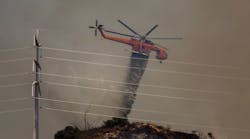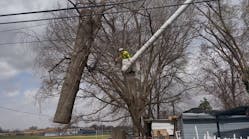Southern California Edison this month filed its proposed 2019 Wildfire Mitigation Plan with the California Public Utilities Commission.
The plan is intended to address and greatly reduce fire ignitions caused by utility infrastructure. It also is intended to further fortify the electric system against the increasing threat of extreme conditions driven by climate change and the impacts of wildfires if they occur. About 35% of SCE’s service area is located in high fire risk areas.
The proposal is the first of what will be an annual submission of a Wildfire Mitigation Plan required by Senate Bill 901, which was passed last year and serves as a first step toward addressing rapidly growing wildfire challenges in California.
SCE has long taken substantial steps to reduce the risk of wildfires in its territory, including employing robust design and construction standards, vegetation management activities and operational practices.
The Wildfire Mitigation Plan is part of a larger, ongoing effort and incorporates and builds on the $582 million Grid Safety and Resiliency Program SCE submitted last September to the utilities commission. SCE will seek opportunities to accelerate wildfire mitigation efforts beyond 2019 compliance goals in the plan where possible.
“At SCE, the safety of the public, our customers, our communities and our employees and contractors is always our first priority,” said Phil Herrington, SCE’s senior vice president of Transmission & Distribution. “This is an aggressive plan to protect public safety. We are implementing a variety of additional tools and technologies to advance fire safety even further throughout our system to respond to the ‘new normal’ of year-round wildfire risk.
“We are setting the bar high and putting extraordinary effort into meeting tough goals,” Herrington added. “We are going far beyond traditional good utility practices and incorporating advanced mitigation measures deployed in high fire risk regions around the world.”
The plan takes a broad approach that includes enhanced inspections on all of the company’s overhead power lines in high fire risk areas in the immediate term to identify and remediate potential issues outside of standard inspection cycles. It will further harden infrastructure, bolster situational awareness capabilities, enhance operational practices and harness the power of data and technology.
The plan also includes specific metrics that provide transparency to the public and other stakeholders and will enable the utilities commission to evaluate SCE’s performance.
This year, SCE proposes to remove 7,500 additional hazard trees as part of the Hazard Tree Mitigation Program; replace conductor across 96 circuit miles; install more than 7,800 fuses on unfused lines; install 62 high-definition cameras and 350 micro weather stations in addition to those already existing in its network; and inspect 100 percent of overhead lines in high fire risk areas.
SCE believes that the commission should deem that a utility has acted prudently for cost recovery if it is found to have substantially complied with its plan.
Initiatives to Further Harden Infrastructure
Covered Conductor — SCE already has replaced more than 150 miles of power lines with covered conductor and continues deploying covered conductor in high fire risk areas. Many of the ignitions associated with utilities are caused by objects that contact distribution power lines or conductor-to-conductor contact. Covered conductor has proven to be an effective mitigation measure against these ignition sources.
Current Limiting Fuses — The plan includes the installation of fast-acting current limiting fuses at thousands of locations. These devices will interrupt electric current more quickly and should significantly reduce the risk of ignitions when there is a short circuit on the company’s distribution circuits.
Automatic Reclosers — SCE is updating the protective settings for circuits serving high fire risk areas. It is adding automatic reclosers to remotely isolate portions of circuits when needed. This reduces the number of customers impacted during a pre-emptive power shutoff in high fire risk circumstances.
Inspection & Remediation
SCE has launched enhanced overhead inspections of its infrastructure in high fire risk areas. These inspections go above and beyond traditional inspections. The company is taking a holistic look at all potential challenges and working to quickly address any findings. This includes all the overhead assets it has across its transmission, sub-transmission and distribution system in high fire risk areas.
Projects Increasing Situational Awareness
SCE is deploying weather stations, advanced weather modeling software and computer hardware, and high-definition cameras.
These technologies will increase the company’s ability to monitor weather and micro-climates in high fire risk areas, more accurately predict inclement weather conditions and identify and proactively repair equipment.
By the end of 2020, SCE expects to have up to 850 weather stations deployed — more than 125 already have been installed — as well as up to 160 high-definition cameras providing coverage of up to 90 percent of high fire risk areas across its service area.
Enhancing Operational Practices
Vegetation Management — SCE is proactively identifying and mitigating trees outside required clearances that may pose a potential risk to the company’s power lines.
Infrared Cameras — SCE is using infrared cameras to inspect its equipment to identify potential issues that could lead to fire ignitions.
Temporary Power Shutoffs — SCE is enhancing its Public Safety Power Shutoff (PSPS) program. This is an operational practice in which the company pre-emptively turns off power during high fire risk weather conditions to enhance public safety. PSPS will be used to complement infrastructure hardening measures when weather conditions threaten power lines in a way that presents an imminent danger to public safety.
SCE is committed to providing timely notification to potentially impacted customers, local governments, public safety agencies and the California State Warning Center before, during and after a de-energization event. The company also will continue to work with local governments and public safety agencies, as well as critical care customers, essential service providers and business customers, to refine the program.
Public Outreach
Last year, SCE launched a community outreach effort aimed at raising awareness about what the company is doing to address wildfire risk, particularly around PSPS. SCE is helping customers to be better prepared for emergencies and directing them to resources where they can receive aid.
SCE hosted more than 20 community meetings and invited more than 1 million customers in high fire risk areas to participate. Company representatives met with more than 120 cities, counties and tribal governments. SCE also conducted dozens of power shutoff workshops with its essential service providers and coordinated with emergency management agencies.
Harnessing the Power of Big Data
SCE is piloting machine learning and analytics, also known as “big data,” to improve automated sensing of electric system and equipment conditions. The company is using data such as wind speed; conductor type, size and length; equipment manufacturer; type of transformer; and other factors, and is building its ability to analyze and practically apply patterns and correlations to the company’s operations.
This big data effort will drive improvements in safety and reliability across the electric grid as these capabilities mature and expand.


